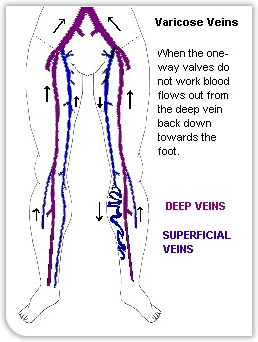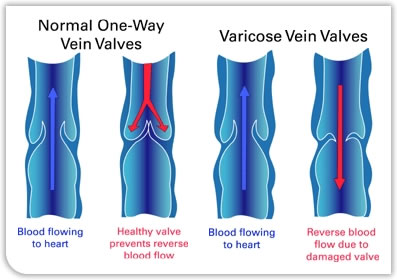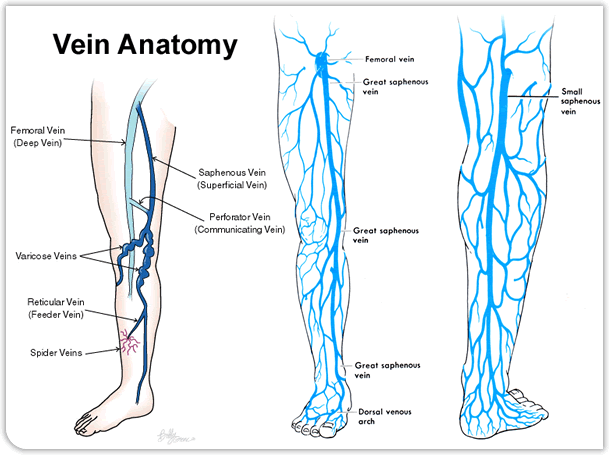Varicose Veins
What are Varicose Veins?
The veins carry blood uphill from the foot back towards the heart.
There are two sets of veins in the leg, the deep veins, which are buried deep inside the muscles and cannot be seen, and the superficial veins that are near the surface.
Both sets of veins have one-way valves in them to help blood flow uphill but prevent it coming back down again.
When the valves in the superficial veins don't work pressure builds up in these veins and the veins become dilated and wiggly under the skin.
This is the cause of varicose veins. Varicose veins are very common and often tend to run in families.


What problems can Varicose Veins cause?
Many people dislike the appearance of varicose veins and find them ugly. They can also ache particularly when people have been on their feet for long periods of time.
They may also cause eczema and occasionally skin discolouration and brownish pigmentation around the ankles, which can lead to ulceration.
However, most varicose veins do not cause leg ulcers.
Sometimes the veins can become hard and tender and feel hot. This is called Phlebitis and can be very unpleasant. The good news is that it gets better on its own but may take six weeks or so to settle in. Low molecular weight heparin (a blood thinner) helps to prevent the clot extending and is particularly helpful if the clot is close to the deep veins (in the groin or behind the knee). Anti-inflammatories such as Ibuprofen can be helpful. There is no need for antibiotics.
 Are Varicose Veins dangerous?
Are Varicose Veins dangerous?
No.
What treatments are available?
Since varicose veins are not dangerous there is a choice about whether to treat them.
Doing nothing is an option. If aching is the main problem then support stockings or tights can often go a long way to relieving discomfort although they will not get rid of the veins themselves.
However, in my experience, most people who bother to see their GP or a specialist are fed up with their veins and want something doing about them. Treatments available are described below together with an idea of their pros and cons.
There are three main ways of treating varicose veins
What treatment is best for me?
Sometimes the variety of treatments on offer can seem confusing, it is worth pointing out that they are all effective ways of treating varicose veins. The best choice depends in part in the type of veins you have, for example very large veins do not do well with foam sclerotherapy, it may be difficult to pass a catheter up a very wiggly vein.
So some people may not be suitable for all the various treatments. If you are suitable then it is to some extent a matter of personal preference. The great thing about radiofrequency ablation/EVLT and foam is that they do not require a stay in hospital, are done under local anaesthetic and normally have a very rapid return to full activity.
Some people just do not like the idea of an operation under local anaesthetic and it is perfectly possible to have a general anaesthetic. Radiofrequency ablation/EVLT is more reliable than foam sclerotherapy, and is less likely to cause phlebitis and skin staining. It is also somewhat more expensive as it requires more equipment and time to perform. In many people the varicose veins which are obvious to see are branches arising from the major veins.
Treating the main feeding vein will make these branches disappear about 75% of the time. However, if they do not disappear a further session of treatment may be needed. Again, people under severe time pressure or coming from abroad may decide to get all their veins treated in one go under a general anaesthetic.
The most important thing is to discuss which treatment is best for you with a specialist who can do all of them, then you can decide between you which option is the best for you as an individual.
